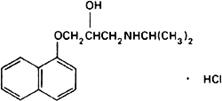Monographs: Pharmaceutical substances: Propranolol hydrochloride (Propranololi hydrochloridum)
Molecular formula. C16H21NO2,HCl
Relative molecular mass. 295.8
Graphic formula.

Chemical name. (±)-1-(Isopropylamino)-3-(1-naphthyloxy)-2-propanol hydrochloride; (±)-1-[(1-methylethyl)amino]-3-(1-naphthalenyloxy)-2-propanol hydrochloride; CAS Reg. No. 318-98-9.
Description. A white or almost white, crystalline powder; odourless.
Solubility. Soluble in water and in ethanol (~750 g/l) TS; practically insoluble in ether R.
Category. Antiadrenergic.
Storage. Propranolol hydrochloride should be kept in a well-closed container, protected from light.
Requirements
Definition. Propranolol hydrochloride contains not less than 98.0% and not more than 101.0% of C16H21NO2,HCl, calculated with reference to the dried substance.
Identity tests
A. Carry out the examination as described under 1.7 Spectrophotometry in the infrared region. The infrared absorption spectrum is concordant with the spectrum obtained from propranolol hydrochloride RS or with the reference spectrum of propranolol hydrochloride.
B. The absorption spectrum of a 20 μg/mL solution in methanol R, when observed between 230 nm and 350 nm, is qualitatively similar to that of a 20 μg/mL solution in methanol R of propranolol hydrochloride RS (maxima occur at about 290 nm, 306 nm, and 319 nm). The absorbances of the solutions at their respective maxima do not differ from each other by more than 3%. The absorbances of a 1-cm layer at those wavelengths are about 0.42, 0.25 and 0.15 (preferably use 2-cm cells for the measurement and calculate the absorbances of 1-cm layers).
C. A 20 mg/mL solution yields reaction B described under 2.1 General identification tests as characteristic of chlorides.
Melting range. 161-165°C.
Specific optical rotation. Use a 0.10 g/mL solution; the substance is optically inactive.
Clarity and colour of solution. A solution of 0.20 g in 10 mL of water is clear and not more intensely coloured than standard colour solution Yw2 when compared as described under 1.11.1 Colour of liquids.
Sulfated ash. Not more than 1.0 mg/g.
Loss on drying. Dry to constant weight at 105°C; it loses not more than 5.0 mg/g.
pH value. pH of a 10 mg/mL solution, 5.0-6.0.
Related substances. Carry out the test as described under 1.14.1 Chromatography, Thin-layer chromatography, using silica gel R2 as the coating substance and a mixture of 140 volumes of dichloroethane R, 60 volumes of methanol R, 2.5 volumes of water, and 2.5 volumes of anhydrous formic acid R as the mobile phase. Apply separately to the plate 10 μl of each of 2 solutions in chloroform R containing (A) 10 mg of the test substance per mL and (B) 0.050 mg of the test substance per mL. Develop the plate for a distance of 10 cm. After removing the plate from the chromatographic chamber, allow it to dry in air, and examine the chromatogram in ultraviolet light (254 nm). Any spot obtained with solution A, other than the principal spot, is not more intense than that obtained with solution B.
Assay.
Dissolve 0.250 g in 25 mL of dehydrated ethanol R. Carry out a potentiometric titration using 0.1 M sodium hydroxide (0.1 mol/L) VS, as described under 2.6 Non-aqueous titration.
1 mL of 0.1 M sodium hydroxide (0.1 mol/L) is equivalent to 29.58 mg of C16H21NO2,HCl.